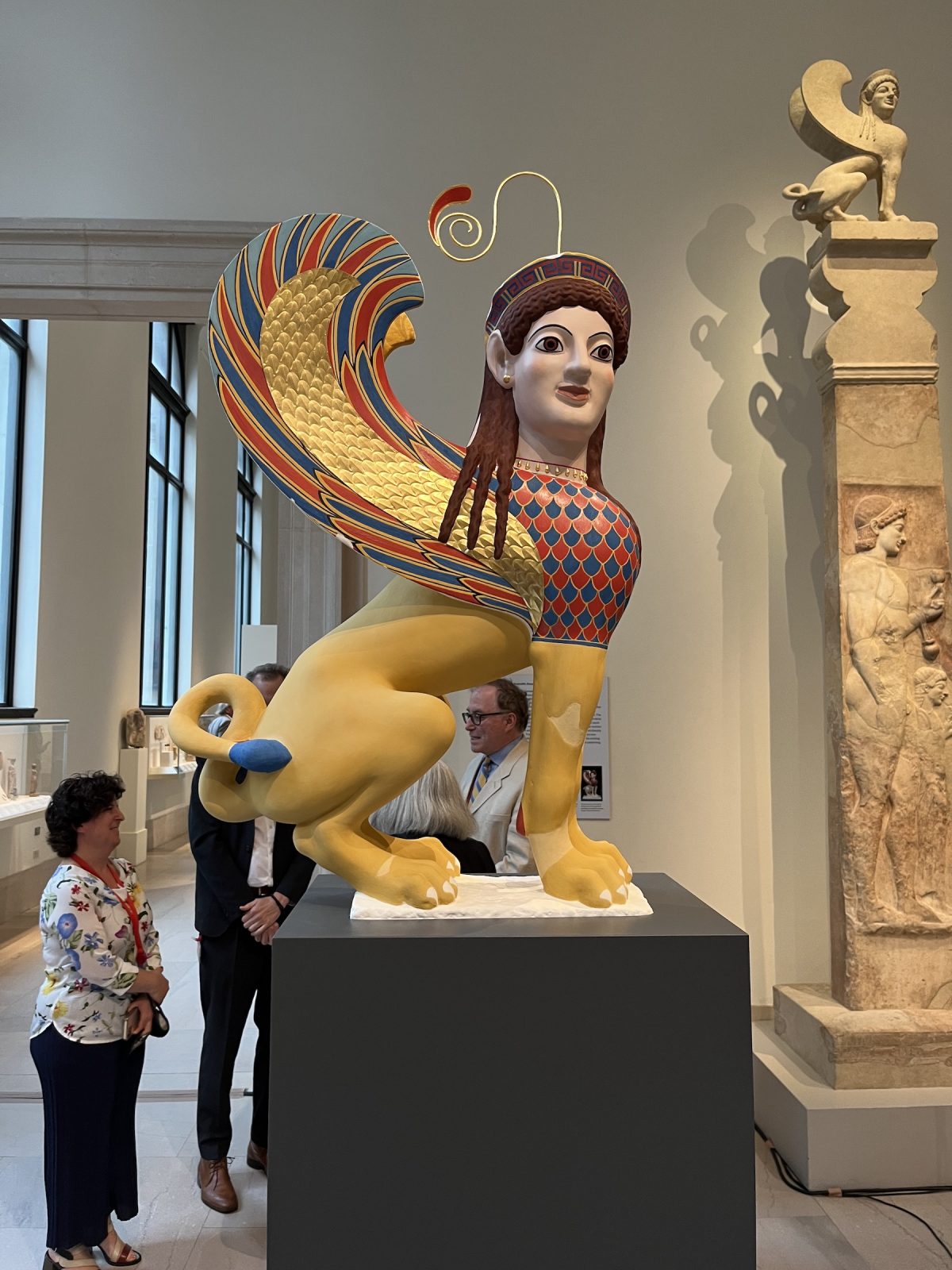
In Ancient Greece in 530 BCE, visitors to the grave of a young boy and girl would have gazed toward the sky and seen a brightly painted sphinx perched atop the 13-foot marble stele that marked the children’s final resting place.
The stele and sphinx, on display as part of the collection of the Metropolitan Museum of Art, appear just like the other sculptures in the museum’s sun-lit halls — a stark white. But a new exhibition, Chroma: Ancient Sculpture in Color, showcases the sphinx in its original vibrant form, one of 14 painted reconstructions of Ancient Greek and Roman statues. On view through March 23 of 2023, Chroma also highlights 40 other objects that contextualize polychromy, the painting of ancient sculpture and pottery.

Chroma is the outcome of an extensive collaboration between conservators, scientists, and curators who helped to create the replica of the sphinx. The exhibition’s other reconstructions were created by Vinzenz Brinkmann, head of antiquities at the Liebieghaus Skulpturensammlung in Frankfurt, and Ulrike Koch-Brinkmann. The husband-and-wife team has studied polychromy for over 40 years. Their Gods in Color exhibition has been touring since 2003, and their replicas have been included in museums around the world.
Instead of relegating the colorful reconstructions to a separate gallery space, the works at the Met are interspersed within the museum’s iconic ancient sculpture halls, with a small upstairs gallery dedicated entirely to the show. Throughout the exhibition, labels explain the scientific process for determining the statues’ true colors.
Sarah Lepinski, associate curator in the Met’s Department of Greek and Roman Art, wanted the works to be in dialogue with the museum’s collection. When possible, the replicas are displayed near comparable works (the originals are dispersed in collections throughout the world). But in the case of the sphinx, the reproduction stands adjacent to the real thing.
“We thought this would work best for understanding the pieces within their historical context,” Lepinski told Hyperallergic.

That art historical context is exceedingly broad: Curator Seán Hemingway told Hyperallergic that most Ancient Greek and Roman statues have traces of their original polychromy and can be reconstructed in color. For the ancient Greeks and Romans, white marble was not considered the final product, but rather a blank canvas. So why do these bright, multicolored statues still shock us?
Hemingway spoke to the grim implications of whitewashing ancient art: Not only does a stunted understanding of ancient polychromy present a version of history in which societies were more White-centric than they actually were, but it renders the Classical ideal, upheld as an aesthetic standard for art and beyond, also White.
“White supremacists have latched onto this idea of white sculpture — it’s not true but it serves their purposes,” Hemingway said. “There are people like that who make their own argument out of what they want to believe. And then there’s all this evidence that shows that sculptures were brightly painted, but they’re often not very well preserved.”
Hemingway said there is still a lot that scholars don’t know, adding that statues that spent time in Victorian collections are particularly difficult to reconstruct because they were cleaned so extensively.


To determine the coloring of the ancient statues, Brinkmann and Koch-Brinkmann applied both scientific techniques and art historical research. In their reconstruction of an Ancient Greek statue of an archer, for example, the pair used ultraviolet and raking light to determine the patterns that were initially painted on its surface before employing detailed technical photography to observe what remained of the archer’s colors.
Then, they delved into art historical clues: A well-preserved Persian rider from the Acropolis in Athens helped Brinkmann and Koch-Brinkmann determine their archer’s palette. Flecks of gold were also placed on the replica after the team studied Greek pottery and Scythian textiles that bore similar clothing patterns to that of the archer.

Although Brinkmann and Koch-Brinkmann have been studying ancient polychromy for nearly half a century, they certainly were not the first to observe it. In the small upstairs gallery dedicated to the exhibition, a striking 1919 watercolor portrays statues in the Acropolis in Athens at the time of their discovery and before they were exposed to the elements.
The watercolor begs the question: Why do these reproductions still strike some visitors as out of place in the halls of the Met when people have known about their polychromy for so long? With extensive scientific explanation and lifelike replicas, Chroma leaves no doubt in visitors’ minds that ancient statues were painted. And maybe this major museum show will finally change the way we think about ancient sculpture — not as pristine and white, but as colorful, vibrant artistic expressions.
0 Commentaires